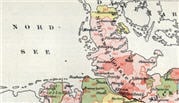Source Information

About Karlsruhe, Germany, Deaths, 1870-1951
About this collection
This collection contains death records from Karlsruhe covering the years 1870 up to and including 1951. Karlsruhe is the second largest city in the German state of Baden-Württemberg and is situated about 4 miles east of the right bank of the Rhine River. The city was established in 1715 by Charles III William, Margrave of Baden-Durlach, and takes its name from the German for "Charles' Rest." The city is nicknamed the "fan city" (die Fächerstadt) because of its design layout, with straight streets radiating fan-like from the Palace. It's also now known as being the headquarters of Germany's Federal Court of Justice and the Federal Constitutional Court. During the time period of this collection, Karlsruhe belonged to the Grand Duchy of Baden until 1918 and afterwards, until 1945, to the Republic of Baden. In addition to Karlsruhe this collection includes records from another 19 communities including Knielingen, Durlach and Mühlburg. These latter communities have become boroughs of modern Karlsruhe but each enjoys an individual historical heritage. In 1935, the communities of Welschneureut and Teutschneureut were combined into Neureuth. The last year for records varies by community.
Beginning on February 1, 1870, birth, marriage and death records in the former Grand Duchy of Baden were created by local registry offices. The collected records are arranged chronologically and usually bound together in the form of yearbooks. These are collectively referred to as "civil registers." Occasionally, alphabetical directories of names were also created. While churches continued to keep traditional records, the State also mandated that the personal or marital status of the entire population be recorded.
What you can find in the records
Death records were created using preprinted forms that were filled in by hand by the registrar. In each record the date of death usually differs from the date it was registered. Depending on the individual form or on the formulations used by the registrar, you may find:
- Sequential or Certificate Number
- Registration Date
- Informant: Occupation, Given Names, Last Name, Residence/Address
- Deceased: Occupation, Given Names, Last Name, Maiden Name, Age/Birthdate, Denomination, Residence/Address, Birthplace, Marital Status, Spouse/Parents, Place/Date of Death, Time of Death
- Beginning in 1938, the records may also include a Cause of Death and cross references to corresponding birth and/or marriage registers
- Signatures
More about using this collection
Earlier records, before 1876, initially had four death records per page, then two. After the introduction of a number of uniform formats, each record comprises an entire page. Additional events from the life of the deceased were sometimes recorded later on in the margins. These notes, sometimes referred to as "narration," can contain very useful information but they have not been indexed. As a result, information from the notes will not found via the search form. The “Informant” was usually a relative of the deceased. In later years death information was often submitted by hospital administrators. These records also document casualties (Kriegssterbefälle) from the Second World War. Under "Browse this collection,” select the Register Type, Civil Registration Office and Year Range of the register desired. If a name directory was created for a community, it can be found at the end of each respective register.
 Need help with the German language? Find resources in our German Research Center.
Need help with the German language? Find resources in our German Research Center.